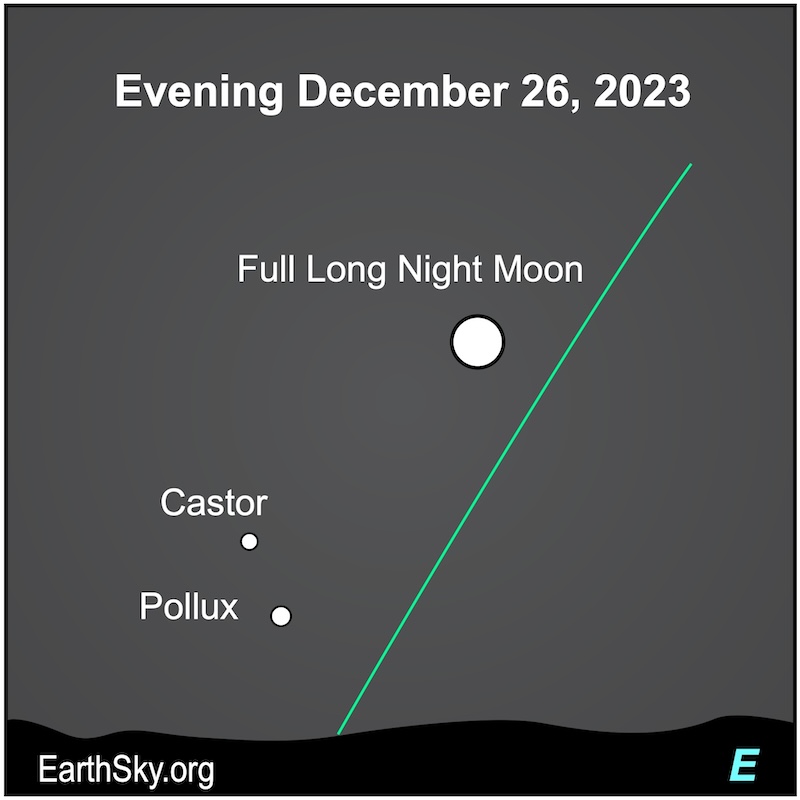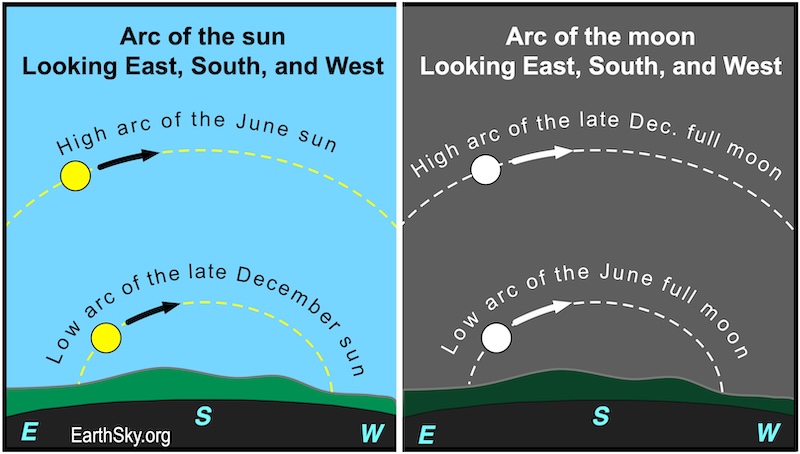
When and where to look in 2023: For us in the Northern Hemisphere, the bright, round full moon will rise in the east around sunset for several nights in a row: December 25, 26, and 27.
Crest of the full moon falls at 00:33 UTC on December 27. That’s 6:33 p.m. CST on December 26, and about ninety minutes after sunset in central North America. And that’s also the moment when this month’s moon is most directly opposite the sun as seen from Earth. The moon is roundest on the day when it is full, but the day before and after, it appears almost, but not quite full.

The 2024 lunar calendars are here! Best New Year’s gifts in the universe! Check ’em out here.
December full moon mimics the June sun
Every full moon is more or less opposite the sun. And a full moon’s path through the night is opposite the sun’s path. So, this December full moon’s path roughly follows the sun’s daytime path from six months ago, or six months hence. No matter where you are on Earth, notice the moon’s path on December 26-27. The Northern Hemisphere will see the December full moon rise to nearly the top of the sky, just as the sun does near the June solstice. The Southern Hemisphere will see a low moon, mimicking a low winter sun.

Here’s another way to look at it. In the Northern Hemisphere, the December solstice has the least amount of daylight of the year. Since there’s still about 24 hours in a day no matter how much daylight there is, the shortest day means it must also be the longest night. So, for the moon to stay up all night and remain roughly opposite the sun, it needs to take a longer path across the sky. The higher an object crosses the sky, the longer its path and the longer it stays above the horizon.
Tracing the high path of the December full moon
To see for yourself, try this: Trace a line with your finger from east to west to emulate the sun’s path in December. If you’re in the Northern Hemisphere, you’ll be tracing a low arc above the southern horizon. If you’re in the Southern Hemisphere, you’ll be tracing a high arc above the northern horizon.
Then, with your finger, trace another path high overhead. Now you’re emulating the moon’s December path, and you’ll see it’s a longer path than the lower one. And likewise, if you are in the Southern Hemisphere, trace a low arc to emulate the moon’s December path.
Little by little, we can watch the two paths come back into balance. Each month, the full moon will cross the sky at a slightly lower arc than the previous month. Each successive full moon will take less time than the previous one to cross the sky.
What about an equinox moon?
At March’s full moon, which is near the Northern Hemisphere’s spring equinox, the two paths – of the moon and of the sun – will be nearly the same. Then, near the June solstice, those of us in the Northern Hemisphere will see the sun cross high overhead during the year’s longest days. And, during the short northern summer nights, we’ll see the moon cross a lower path on the sky dome and spend less time in the sky.
And on the cycle goes.
Names for the December full moon
Of course, now we see why they call December’s full moon the Long Night Moon.
But – like all full moons – the full moon of December has many nicknames: Long Night Moon, Full Cold Moon, and in Decembers when it falls before Christmas, Moon Before Yule. But no matter which name appeals to you, be sure to notice the moon’s high path!
Last full moon of 2023
This full moon is the last full moon of 2023. It is also the first full moon of the Northern Hemisphere’s winter – and Southern Hemisphere’s summer.
Plus it is the closest full moon this year to the December solstice, occurring just five days after. This solstice marks the start of winter in the Northern Hemisphere and summer in the Southern Hemisphere. It lands at 3:27 UTC on December 22, 2023. That’s 9:27 p.m. CDT on December 21, 2023.
December full moon in Gemini
The December full moon can lie in front of one of two constellations of the zodiac and two additional constellations. This year it lands at the foot of Gemini, but in most years it falls in Taurus. And in 2026, it will occur in the constellation , Orion. Very rarely, though, the exact moment of full moon happens when it passes along the southern edge of Auriga.

Enjoy December’s full moon!
Bottom line: The 2023 December full moon happens overnight on December 26-27, 2023. It closely follows the path of the June sun. It also lies in the zodiacal constellation Gemini and is near that constellation’s twin stars, Castor and Pollux.











